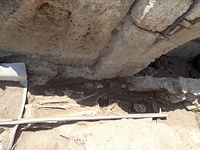| Collection: | Corinth | |
| Type: | Basket | |
| Name: | Temple E, Southeast, context 1025 | |
| Area: | Temple E, Southeast | |
| Context Type: | Skeleton | |
| Title: | Primary Inhumation in Grave 2016-09 | |
| Category: | Deposit | |
| Notebook: | 1110 | |
| Context: | 1025 | |
| Date: | 2016/06/10 | |
| Notes: | This is a primary inhumation exposed beneath the tile covering structure 1016. The individual is supine with the cranium elevated, facing east, and tilted slightly to the south, seemingly resting the right cheek on a concave tile lying on top of the right side of the chest and abdomen. The legs, while straight are situated very close to one another. The femora are twisted so that the anterior aspect of the condyles are essentially facing one another and almost touching. The tibiae are parallel to one another, the ankles likely touching. There is a jumble of bones situated directly north of the right lower limb (Context 1027), including a femur, a sacrum, a clavicle, vetebrae, and cranial fragments. The arrangement of the lower limbs suggests that the individual might have been tightly wrapped in something like a shroud at the time of burial. The feet are side by side, possibly on the plantar aspects. The shoulders are elevated and the humeri drawn in so that they rest on th elateral aspects of the rib cage. The forearms are crossed, bent at the elbow so that the left forearm is over the right forearm. The hand would have been at the midshaft of the R humerus (later note: in removing the skeleton, we found hand bonds at this point, which appeared to have become disarticulated over time possibly due to their positioning in the shroud.) The right hand is likely under the left elbow. The mandible associated with the cranium is articulated, but hinged open. A triangular rock was dug from below, but to the east of the mandible, indicating it may have been a rock designed to prop the mandible up. Unfortunately, in the course of exposing the cranium, the frontal bone, zygomatics, and superior maxillae were damaged and collapsed into the cranium. It may be possible to reconstruct the vault from the fragments. Prior to its collapse, I observed that the supraorbital margin appeared thin, the forehead was fairly vertical, and glabella was gracile. Further observation of the rest of the cranial features will provide more information regarding the sex of the individual. It is likely an older adult as they are edentulous. 2016/06/13 A fingerbone with an iron ring on it was recovered on 6/13 at 1068.85 N, 124.6 E that most likely belongs with this skeleton and is given its context number. It was not removed with the rest of the skeleton because it was close to the stone lining of the grave and was covered by some soil. The finger bone was sent to the museum with the ring still around it (It was found at elevation 84.60). | |
| Period: | Frankish (1210-1458 AD) | |
| Chronology: | late 13th c. | |
| Grid: | 126.6-124.4E, 1068.4-1068.95N | |
| XMin: | 124.4 | |
| XMax: | 126.6 | |
| YMin: | 1068.4 | |
| YMax: | 1068.95 | |
| Site: | Corinth | |
| City: | Ancient Corinth | |
| Country: | Greece | |
| Masl: | 84.73-84.87m. | |
| References: | Images (5) Object: MF 2016 62 |
|
Show All Results (3,986) Reports (18) Plans and Drawings (318) Images (2,069) Baskets (1,569) Notebooks (3) Classifications Sign in Provide feedback |
|


